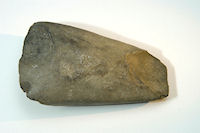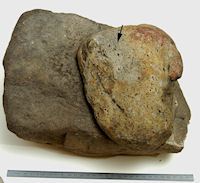
Figure 4: Axeheads and watercourses
There is a marked contrast in the distribution of axeheads between the three landscape zones of the Foulness Valley. Of the 57 axes with known locations, no axeheads were recorded in Zone 3, 9 in Zone 1 and 48 in Zone 2 (Table 2). It could well be, as discussed above, that artefacts lie under later protective layers of alluvium; however, it is possible that drier areas offered by the sandy rises of Zone 2 were preferred. When the axeheads were examined against other wetland areas and watercourses in Landscape Zone 2 however, 28% were within 50m of an area of wetland or a water source, with 70% being within 500m.
The condition of some of the tools suggests that they had never been used. Two of the finest finished were a flint adze resembling those of Seamer-Duggleby type from Hasholme Carr Farm, Holme-on-Spalding Moor (Fig. 5) and a Group XVIII axehead (Fig. 6) found close by.

Figure 5: Flint adze blade from Hasholme Carr Farm, Holme-on-Spalding Moor. L. 182mm, 40mm across the cutting edge. The quality of workmanship relates this adze to the exotic, specialised, broad-butted 'Duggleby' adzes and 'Seamer' axes (Manby 1974, 98-100). However, its squarish cutting edge contrasts with the semi-circular cutting edges of the Duggleby and Seamer types. The delicate nature of the Hasholme example and its fine polished finish place it within the prestigious class of Later Neolithic flint working (Manby forthcoming).

Figure 6: Group XVIII (Dolerite) axehead from Hasholme Carr Farm, Holme-on-Spalding Moor. Heavy Axe Blade Class C5. L. 172mm, 81mm across cutting edge. The fresh condition of the axe is unusual. Note the dark central vertical band of organic origin left by a haft (Manby forthcoming).
A further pair of pristine axeheads (one flint and one stone) was also found close to the River Foulness at Leylandii in the north-west of Holme-on-Spalding Moor parish.

Figure 7: Heavy Axe Blade Class B2 from Leylandii, Holme-on-Spalding Moor, L. 171mm, 70mm across the cutting edge. Asymmetric pointed oval section with rounded butt. Flint, very dense, creamy with white and fawn mottling and deep pockets of chalk skin in the surface. Probably of Wold flint, the cutting edge shows no damage by use. This flint axe class is scarce across Yorkshire, where it reaches the northern extent of its distribution. It is more numerous in Lincolnshire and the Trent Basin (Manby forthcoming).
It is possible that these tools may belong to the series of: 'stone axes of non-local, even continental origin, found in unexpectedly high proportions in springs, bogs and rivers in Britain' (Bradley 1990, 66-7). Their proximity to the river system, however, may relate to its use as a means of communication, either by boat, or as a convenient aid to navigation for travellers on foot through the forested landscape. Further work needs to be done on the deposits in the Foulness Valley from which the tools were derived before the idea of ritual deposition can be fully accepted in this case.
In contrast, many of the axes in the Foulness Valley, especially those of Group VI, were reworked and bore the signs of heavy use; some of them were half their original size.

Figure 8: Group VI: Lake District axehead from Rose Villa, Holme-on-Spalding Moor. Class B2a. L. 102mm, 59mm across the cutting edge. A reworked butt of a large 'Cumbrian' type; the widest part was turned into a new cutting edge ground at acute angles. Subsequently a large flake was taken off one face and small flakes and chipping off the other (Manby forthcoming).
Some corroborative evidence for the use of axes can be observed in the palaeoenvironmental record, as pollen analysis shows that the Lower Foulness Valley was heavily wooded (Halkon and Innes 2005; Turner 1987). The small-scale clearance indicated can be best explained by woodland management for fodder, construction and firewood, rather than clearance for agriculture. Analysis of beetle remains at Hasholme suggests that this activity was not intensive, as many species associated with dead wood were present (Heath and Wagner forthcoming).
Managed woodland from the Foulness Valley lowlands (Zones 1 and 2) may have supplied the timber for the construction of a long barrow at Market Weighton Wold (Zone 1). Pre-mound timber structures are a feature of the East Yorkshire long barrows excavated in the 20th century (Manby et al. 2003), and the full significance of these was not properly recognised in the limited excavations of the mid-19th century (Greenwell and Rolleston 1877). The Market Weighton Wold long barrow is situated at the head of a dry valley overlooking what is likely to have been a major route between upland and lowland. When plotted against the topography (Fig. 9), it was also noticed that many of the axeheads in Zone 1 were also located close to the valleys connecting the lowlands with the uplands of the Yorkshire Wolds, often at their entrances or exits; indeed at Sancton Dale, Group VI axes have been found at both ends. The continuing importance of this valley is demonstrated by the cemetery of at least 18 round barrows (Halkon 2003; Halkon et al. forthcoming), which overlooks it to the north, and the famous Arras Iron Age square barrow cemetery (Stead 1979) at its head. Was the deposition of these tools of ritual significance or were they simply casual losses along a well-used routeway?
Although there will have been some changes to the soils of the study area since the Neolithic, the basic soil types provide an indication of their original properties (King and Bradley 1987; Furness and King 1978). When plotted against a generalised soil map of the Foulness Valley, a stark contrast between the numbers of tools found on different soil types was apparent. From Table 2 and Figure 10 it can be seen that the majority of axes in Zone 1 were found on the Brown Earths and in Zone 2, 44% were located on the sandy soils, with 31% on Brown Earths. The latter is the most fertile soil type in the region (King and Bradley 1987; Furness and King 1978), and the sandy soils the most easily worked. The remainder of the axes were found on or close to areas of alluvium or peat. In the earlier Neolithic, a period of high sea-level (see above), some of these were probably open water.
| Soil | Zone 1 | Zone 2 | Zone 3 |
|---|---|---|---|
| Alluvial loam | 0 | 0 | 0 |
| Alluvium | 0 | 4 | 0 |
| Marine alluvium | 0 | 0 | 0 |
| Peat | 0 | 5 | 0 |
| Clay | 1 | 1 | 0 |
| Loamy clay | 0 | 1 | 0 |
| Brown Earth | 5 | 15 | 0 |
| Calcareous | 3 | 1 | 0 |
| Sand | 0 | 21 | 0 |
| Total | 9 | 48 | 0 |

Figure 10: Axeheads and soils (after King and Bradley 1987)
The distribution of axeheads coincides with that of other artefacts (Halkon 2003) in suggesting an opening out/clearance of the landscape away from the lower Foulness Valley in the mid/later Neolithic, possibly for agriculture, an observation which seems to be supported by palaeoenvironmental analysis elsewhere in the Vale of York at Askham Bog (Van de Noort et al. 1999, 271). To the east of the Walling Fen inlet at South Cliffe Common, clustering of axeheads (Fig. 10) coincides with concentrations of scrapers, a single-piece flint sickle and complete saddle quern (Fig. 11), almost certainly of Neolithic origin, which may attest to some form of settlement and associated agricultural activity (Halkon 2003; Halkon and Innes 2005; Halkon et al. forthcoming). The top stone of the quern, now on display in the Hull and East Riding Museum, Hull, bears a groove identified by Manby and Spratt (pers. comm.) as having been created by the constant sharpening of polished stone axeheads.

Figure 11: Saddle quern from South Cliffe Common (top stone diameter: 240 x 200mm, height: 60mm). Made of sandstone from the Lias bench close by, the two stones had weathered together in situ. The arrow indicates a groove, almost certainly created by polishing stone axes
The sandy soils here, though limited in fertility, were easy to work; however, as in East Anglia, the area became heathland, with the destruction of vegetation accelerating podzolisation (Lawson 1981).
There is a further cluster of axeheads on an area of Brown Earths around Pocklington (Fig. 10), which may also relate to settlement and possibly some form of agriculture. At Hayton (Halkon et al. 2000; Halkon 2003) close to the chalk stream of Hayton Beck, three pits were found containing animal bone (mainly cattle) and Grooved Ware pottery, including fragmentary elaborately decorated Woodlands style 'tubs' (Manby pers. comm.). The presence of hazelnuts in the pits dated to 2920 to 2860 cal. BC (cal. BP 4870 to 4810) and 2810 to 2690 cal. BC (cal. BP 4760 to 4640) 2 Sigma (Beta 223632) demonstrates continued use of woodland resources. The Grooved Ware may suggest some form of ritual selective deposition, as postulated elsewhere in East Yorkshire (Manby 1974; Manby et al. 2003). Pits containing Durrington Walls style Grooved Ware was found in excavations by Northern Archaeological Associates prior to the construction of a waste water treatment plant near Pocklington, about 1km to the north-west (Manby pers. comm.).
© Internet Archaeology/Author(s) URL: http://intarch.ac.uk/journal/issue26/12/5.html
Last updated: Wed Jul 1 2009